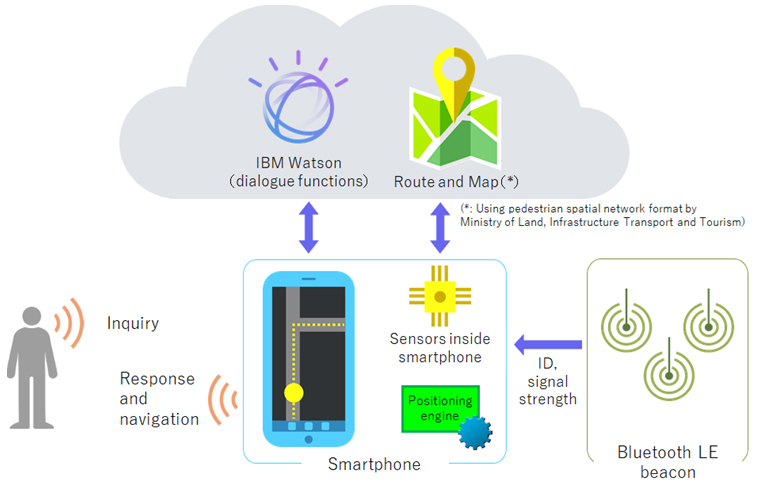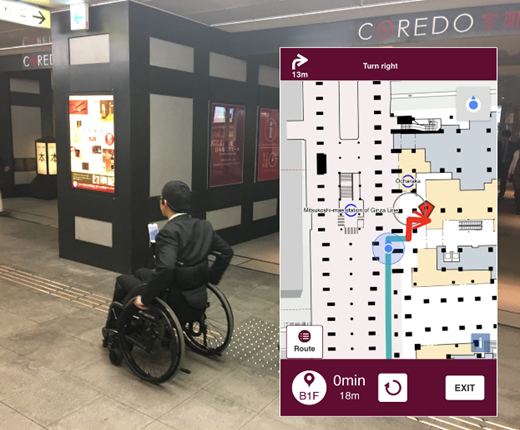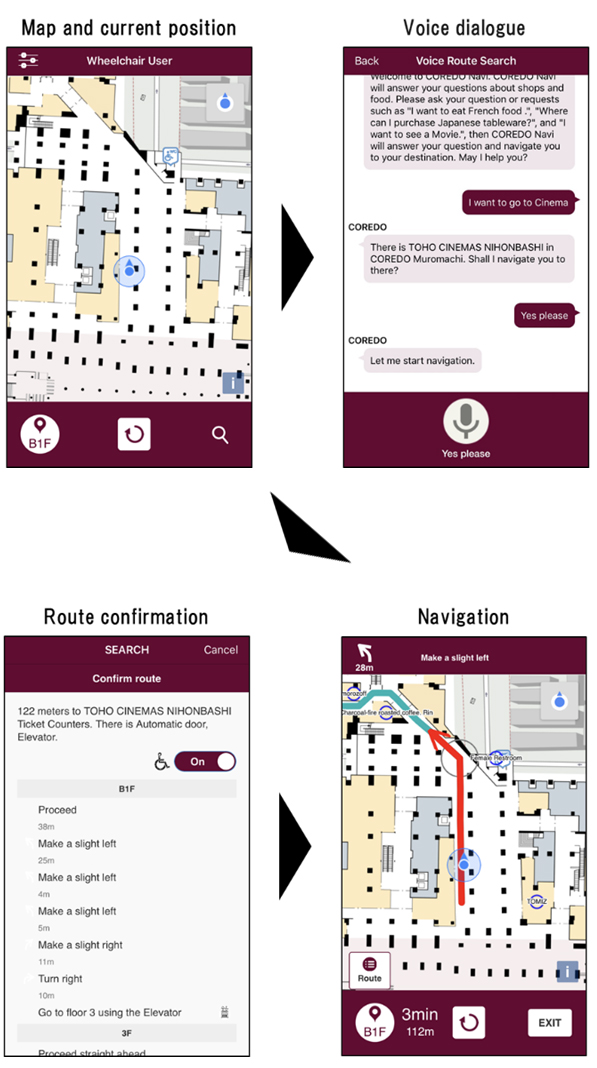First High-Precision Voice Navigation System in Japan
in Nihonbashi Muromachi District
“Inclusive Navi” Provided as a Service
Creating Barrier Free, Stress Free Neighborhoods
October 11, 2019
Mitsui Fudosan Co., Ltd.
Shimizu Corporation
IBM Japan, Ltd.
Tokyo, Japan, October 11, 2019 - Mitsui Fudosan Co., Ltd., a leading global real estate company headquartered in Tokyo, Shimizu Corporation (“Shimizu”, Head Office: Tokyo. President: Kazuyuki Inoue), and IBM Japan, Ltd. (“IBM Japan”, Head Office: Tokyo, Representative Director and President: Akio Yamaguchi) announced that they had jointly built an indoor positioning system for COREDO Muromachi 1-3, and implemented an “Inclusive Navigation” service in October, offering barrier-free navigation by linking the dialogue function of IBM Japan’s AI technology, IBM® Watson.
The service uses a high precision indoor/outdoor voice navigation system that features high precision indoor location measurement based on the transmission signal strength of beacons, linking this with Watson dialogue functions provided on IBM Cloud. The system directs visitors to their respective destinations comfortable and appropriately, in Japanese or English, including visitors who use wheelchairs or baby strollers, or people with visual impairments. The introduction of this service is aimed at building an urban environment that can support the activities of all kinds of people, including foreign visitors and people with disabilities, evolving Japanese hospitality by making use of the service, and realizing barrier-free, stress-free (*1) neighborhoods.
The prototype system evaluated in the “field experiment of high precision indoor/outdoor voice navigation system” conducted in February 2017 has developed into Japan’s first actual service. This is the first step towards expanding the supported areas and creating a new service using the top-level high precision indoor/outdoor positioning environment in Japan (*2).
Mitsui Fudosan has been promoting an urban smart city model project in collaboration with local government and the community in the Nihonbashi area, and has been actively investigating the use of ICT in neighborhood creation. To this end, the Company is promoting collaboration with divers partners assuming not only field experiments, but actual implementation.
Looking ahead, the Company plans to expand the service to Nihonbashi Mitsui Tower in winter 2019, and is also looking at introducing services to other facilities in the Nihonbashi area and providing a new service using high precision location measurement technologies for the system as well as improvements to management efficiency. The Company aims to strengthen urban ICT infrastructure and improve safety and security for the overall Nihonbashi area.

Fig. 1 Conceptual diagram of high precision voice navigation system

Fig. 2. Use of the navigation service by a wheelchair user
<<Roles of the three companies in implementation>>
When implementing the service, Mitsui Fudosan provided various information and floor-plan information of COREDO Muromachi 1-3, such as store introduction and menus. Based on these, Shimizu installed 161 beacons in the supported area and created a system for measuring and detecting the locations of visitors and a navigation map for the target area. In addition, IBM Japan supported construction of the overall system, such as the voice navigation function with dialogue provided using Watson.
<<Supported area>>
The supported area for the service is approximately 20,000 m2 of the urban commercial property COREDO Muromachi 1-3 operated by Mitsui Fudosan.
<<Navigation method>>
(1)Set destination
The visitor starts a navigation app that has been downloaded onto their smartphone, then sets the destination using dialogue, a menu search, and so forth. Specifically, after general pedestrians, wheelchair users, baby stroller users, and people with visual impairments have set these characteristics, the following type of dialogue may be had.
| User | I’d like to have some Chinese food. |
|---|---|
| App | There are three option, 1: Restaurant A, 2: Restaurant B, and 3: Restaurant C in COREDO Muromachi. Which number would you like to go to? |
| User | What kind of restaurants are they? |
| App | Restaurant A is known for “A new XX format. Great hospitality with an authentic Shichuan flavor.” Restaurant B is known for “A popular Chinese restaurant in the media. New style Chinese food by the famous chef, YY.” Restaurant C is known for “Chinese confectionery and dim sum made by a well-established Shichuan style restaurant of Yokohama Chinatown.” Which restaurant would you like to visit? |
| User | The first one please. |
| App | Shall I navigate you to restaurant A? |
(2)Voice navigation
Once the destination is decided, the navigation starts, using voice and a map. The shortest route is provided for general pedestrians, while for wheelchair or baby stroller users, a route without stairs or steps is selected. The user’s current position is shown on the map, while the necessary instructions for reaching the destination are provided almost in real time by voice. Moreover, for users with visual impairments, detailed instructions for moving are provided by voice, such as “walk for nine meters, take the elevator in front of you to the third floor,” “Elevator call button is right side of the door with Braille.” The setting of the destination and the voice navigation are available in both Japanese and English.

Fig. 3 Example of flow from store search to navigation by voice dialogue
How to Obtain the Inclusive Navi App
A Search for “Inclusive Navi” on App Store or Google Play and download the app.

Conditions of use
Users of iPhone (7 or later recommended) or Android (Android 7.0 or later, Bluetooth compatible handsets with accelerometers recommended), who have agreed with the separately specified terms of use.
Glossary and supplementary explanation
*1 Barrier-free, stress free society
A concept proposed by the Ministry of Land, Infrastructure, Transport and Tourism referring to a society where everyone can travel smoothly to their destination, including foreign visitors, the elderly, and people with disabilities.
*2 Japan’s top-level high prevision indoor positioning environment
According to precision survey of indoor positioning environments for largescale spaces such as towns (As of September 2019, three companies surveyed)


























